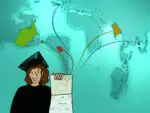Since the beginning of the coronavirus pandemic, countries have closed down their borders and restricted domestic travel. The coronavirus has completely upended the aviation and tourism industries. As we make our way through summer and travel restrictions begin to lift, there has been one prevailing question: What will traveling look like in a world post-COVID?
Before the coronavirus, the forecasted number of air passengers worldwide this year was 4.72 billion. However, in the week of June 1, scheduled flights decreased at a staggering 65.1% in comparison to June 2019.
For those that were traveling amidst the worst of the outbreak, the experience was a long way from what they knew. Dense metropolitan airports became eerie ghost towns — remnants of what once was. While the use of masks and intensified cleaning protocols were universal, different airlines took their own approaches to ensure their passengers’ safety.
Delta and Alaska airlines chose to block their middle seats on flights while others chose to notify their passengers of a crowded plane. International flights have been canceled in an effort to decrease the spread of the coronavirus. The desire to travel in the name of curiosity and adventure dulled as the world stood still.
Now, traveling has begun to slightly increase throughout the summer. Several states have begun their respective stages of re-opening. Countries in the European Union (EU) and Asia have opened their borders. The world is slowly starting to move again and with that comes uncertainty. No one knows exactly how the aviation industry or tourism will recover. We must create and envision new forms of travel for an inevitably new world.
What Will Flying Become?
One thing travelers should expect when traveling in the future is the accelerated use of “touchless technology.”
Ibrahim Ibrahim, the managing director of Portland Design, said in an interview: “We are seeing five years’ innovation in five months, and much of the impact will be permanent. We will see a turbo-charged uptake on tech-driven zero-touch check-in, security and boarding.”
The coronavirus pandemic has caused airports to adapt quickly to the situation they are now facing.
Mobile phones would be used for interacting with check-ins and drop kiosks. Biometric scanning and facial recognition would replace passports to verify identities. Instead of gathering at the gate as people are called to their seats, airlines may choose to bring passengers onboard through mobile phone notifications instead.
Sanitization would also become a priority. Airports have to be cleaned more frequently and thoroughly. Touchless methods will become the primary means for disinfection. Currently, Hong Kong International is testing a full-body disinfection booth that completely disinfects the passenger in 40 seconds. The Louisville Muhammad Ali International Airport in Kentucky has tremendously increased its collection of automated hand sanitizer stations and soap dispensers.
For now, airports are asking passengers to check in online with their health information. The TSA announced on May 21 that passengers would scan their own boarding passes to reduce the potential for contamination. In addition, wearing masks is required when flying. Prior to departure, passengers could go through a thermal body scanner and disinfection tunnel. If they are deemed unfit to fly, they will not be allowed to enter.
Travel Bubbles
James Crabtree, author and associate professor at the Lee Kuan Yew School of Public Policy at the National University of Singapore, believes that a new aspect of traveling will arise: travel bubbles.
The idea is that a network of countries that have successfully managed the spread of the coronavirus will agree to form travel bubbles amongst each other. The infection rate would not have to be 0%, but the countries forming their travel bubbles must be in similar phases of re-opening and controlling the virus. Also, flying would not always be necessary; travelers could opt to drive instead. Those that live in this bubble can travel through these countries freely. No 14-day self-quarantine required.
For the countries that have successfully managed the spread of the coronavirus, the idea has already gained traction. Estonia, Latvia and Lithuania opened their borders to create what they called the “Baltic bubble.” Beijing is entertaining the idea of spreading its bubble to Taiwan, Hong Kong and South Korea. Denmark and Norway have created theirs. Australia and New Zealand are considering forming their own; no official plan has been released yet.
The creation of these travel bubbles could restructure the future of global travel, Crabtree believes. Having a record of success with the coronavirus may be used as a tourism strategy. People will feel safer traveling to countries that have handled the virus efficiently and effectively. Governments would have to be clear on how they are managing the virus and keep their citizens informed.
Movement in these bubbles would be immensely helpful for countries reliant on tourism. According to the United Nations World Tourism Organization, international tourism could decrease by 80% this year. These travel bubbles would not only be a relief to those who wish to venture out into the world again: They could also revitalize global tourism economies.
Virtual Tourism
Virtual tourism already existed before the pandemic. However, as international travel declined during worldwide shutdowns, its popularity started to rise. An abundance of world attractions and museums created new ways for travelers to experience these places from the comfort of their own homes. For instance, Puerto Rico found success in their online “virtual vacation” program. They received an estimated $3 million in ads and saw a 300% increase in Instagram views. Viewers had free access to cocktail classes, salsa lessons and cooking courses.
Countries on the other side of the world are accessible with the click of a button. There is a whole realm of possibilities when it comes to virtual tourism. While there will be some who decide that flying is too risky, they could choose to experience different cultures online instead. For someone who is physically incapable of traveling traditionally, a virtual tourist experience could bring them to anywhere they dream of. It provides opportunities that are not accessible in traditional traveling. Ancient parts of the world that are usually not accessible to the public could be visitable via virtual technology.
It is nowhere near the same as experiencing these sites in person, but in this monotonous, isolating routine of self-isolation, virtual tourism could be a welcome escape.
The possibilities for the future of traveling are endless. Perhaps there would be less over-tourism as people opt to travel less frequently to avoid risk. The increasing developments of technology could form a new, more efficient way of navigating airport terminals. Some may choose to experience the rest of the world online. Whatever the world becomes in the upcoming years, it is certain that traveling will never be the same.

















